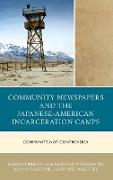- Start
- Community Newspapers and the Japanese-American Incarceration Camps
Community Newspapers and the Japanese-American Incarceration Camps
Angebote / Angebote:
Each incarceration camp had its own newspaper, scholar Takeya Mizuno (2001) has covered the inner workings of those newspapers in great depth. But how the community newspapers closest to the incarceration camps covered their construction and opening has not been explored. Community Newspapers and the Japanese-American Incarceration Camps fills this gap, introducing readers to the reporters and editors for these newspapers and providing in-depth analysis of their coverage of the camps and the evacuees arrival. Dependent on government and military officials for information, these journalists rarely wrote about the violation of the evacuees civil rights. Instead, they concentrated on the economic impact the camps and the evacuees, who would replace workers off to enlist in the military and work for defense contractors would have on the areas they covered. Newspapers like the Cody Enterprise and Powell Tribune in Wyoming (Heart Mountain), the Lamar Daily News (Amache), and the Casa Grande Dispatch (Gila River) regularly published overly optimistic updates on the progress of construction, the size of the contractor payrolls, and the amount of materials used to build the camps. Their boosterism carried over into rosy descriptions of conditions at the camps that at times read like tourist brochures. Our research reveals the tendency of these journalists to promote the camps rather than examine the incarceration is not surprising, since many of them were already unabashed community supporters. The slogan of the Lamar Daily News is a case in point: A newspaper devoted to the upbuilding of Southeast Colorado. Coverage of the camps was typically limited to positive stories of these normal towns. These journalists saw it as their mission to help leaders and business people improve the local economy. Along the way, they reassured readers that they had nothing to fear from the evacuees. They would be under military guard, and would only rarely be allowed to leave the camp often to work on nearby farms. Evacuees were consistently portrayed as cooperative, patriotic, and grateful for the accommodations. As Community Newspapers and the Japanese-American Incarceration Camps reveals, journalists positioned the incarceration camps as a potential economic boon and also as a place where evacuees could escape the dangers of war, dangers they had nothing to do with creating. Evacuees were framed as another community group, there to contribute to the region s economic well-being. Incarceration camps were treated like the mythical city on a hill, symbols of hope for residents that economic recovery would soon occur.
Folgt in ca. 15 Arbeitstagen




